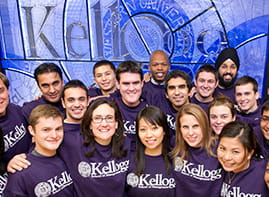9/10/2013 -
In the first installment of the Kellogg-Chase “Growth in Middle-Market Companies” series, Kellogg Professor Mike Mazzeo highlights four guidelines that can help executives develop effective strategies to scale their business.
All small and middle-market businesses strive to identify avenues for growth, but the best path is often far from clear. Executives face the common challenges of trying to monitor industry trends, make strategic investments, and take advantage of emerging opportunities. The Kellogg School of Management and Chase both understand the importance of middle-market companies to the economy as well as the special skills that executives must have to be successful. As no playbook currently exists to help these businesses, Kellogg and Chase have partnered to present “Growth in Middle-Market Companies.” This four-part series brings together Kellogg faculty, Chase experts, and business practitioners for presentations and panel discussions.
In the first session of the series, Kellogg Professor Mike Mazzeo discussed insights from the Roadside MBA Project, which visited more than 120 small and midsize businesses across a range of industries. Mazzeo and his colleagues, University of Utah’s Scott Schaefer and Stanford’s Paul Oyer, interviewed business leaders about their company’s operations, markets, and plans for expansion. Based on this research, Mazzeo shared several guidelines that middle-market companies should keep in mind when pursuing growth:
1. Find opportunities to increase quantity without incurring additional fixed costs. Large investments—for instance, in enhanced production capacity or cutting-edge technology—can hold significant risk for middle-market companies. The loss of several major customers, for instance, can turn a potential competitive advantage into a long-term burden. To reduce the likelihood of this outcome, the best starting point for growth is to identify areas of the business where a product can be designed or produced just once to serve an expanding customer base—essentially achieving economies of scale with limited additional investment.
Learfield Communications, a midsize media company based in Jefferson City, Missouri, succeeded using a classic growth strategy built on economies of scale. First, they identified an under-served market: local radio stations in the Midwest whose listeners rely on daily farm reports. Since small individual stations couldn’t afford to offer this content themselves, Learfield developed a model to produce reports and then distribute them throughout the region. Since the cost to create content for 1 station was virtually the same as the cost to create it for 100 stations, Learfield expanded their profitability considerably as more and more radio stations joined their network of affiliates.
This lesson has applications across a number of industries, not only for digital start-ups and software as a service (SaaS) companies, but also for manufacturers considering technology improvements and transport and logistics businesses with the potential to offer proprietary solutions.
2. Verify that sufficient demand exists before investing in fixed costs. Before making strategic decisions about products or services, executives must first confirm that a customer base exists. Previously, companies often had to take a leap of faith. Today, however, market data―courtesy of industry organizations, federal agencies, and consumer groups―has never been more accessible. By conducting rigorous analysis of information on specific markets, companies can have greater confidence that demand exists to support large-scale investments in production or new-product development.
Steele Rubber, based in Hickory, North Carolina, manufactures rubber parts for classic automobiles that are restored by collectors all over the country and the world. Individual rubber parts are produced from molds that are expensive for Steele Rubber to construct, so the company must carefully evaluate which cars it includes in its catalog. To be profitable, Steele needs to assess whether sufficient demand exists for the parts of a particular car model to justify the fixed costs of crafting molds. The company’s leadership draws information from each state’s Department of Motor Vehicles and collector clubs, among other sources, to estimate how many cars of a certain model have potential for restoration―and a return on investment.
The greater availability of information means that companies in any industry should make market research and analysis a regular component of strategic planning.
3. Ensure that growth is built on superior resources and capabilities. Many companies approach growth with an attitude of, “How could we sell the same product we’re selling to more people?” or “What’s the next adjacent product to our flagship offerings?” These strategies can deliver value but may be somewhat limiting. Middle-market companies should also think hard about opportunities to identify new applications for their core knowledge, skills, or processes.
TiLite, a company located in Pasca, Washington, offers one example. Titanium is an important element in the production of nuclear materials because of its specific physical properties, and TiLite developed expertise in welding and shaping titanium during their years providing parts for nuclear-power companies. Executives identified an opportunity to expand into wheelchair manufacturing and developed a design that used titanium as its frame. Moreover, the company’s superior welding and shaping capabilities enable it to offer wheelchairs customized to an individual user’s height and size—a competitive advantage over many other wheelchair manufacturers.
As TiLite’s experience illustrates, successful companies can develop new markets and extend their reach significantly. This strategy requires executives to look beyond their original industries and geographies by thinking creatively about the applications of their expertise.
4. Recognize the areas of the business that are not scalable. Sometimes when companies grow, they lose the distinctive characteristics―such as efficiency or a unified vision―that made them successful in the first place. If a business’s success is based on its deep knowledge of local markets, for example, expansion into new geographies would effectively put it on even footing with the competition. Similarly, growth can often create additional layers within an organization—rigid infrastructure or an authority hierarchy—that effectively impede innovation and responsiveness to changing market conditions.
GPS Source of Pueblo, Colorado, builds systems that allow the GPS signal to function within buildings or other structures. As GPS technology has become more pervasive, applications have expanded into new industries. GPS Source recently beat out established defense contractors to win a major contract to help the U.S. military utilize GPS in transport planes. An important component in the company’s success was that, as a relatively small organization, GPS Source’s marketing and engineering groups shared information regularly. This exchange of knowledge helped the company to anticipate customer needs and develop new products faster than the competition. As GPS Source embarked on expansion to meet growing demand, its leaders recognized that it might be challenging to maintain the same level of communication with a larger sales force and expanded engineering team.
Business leaders must resist the temptation to grow at any cost—a strategy that can lead to investments that are counterproductive in the long term. Instead, companies that identify the organizational structure, functions, or processes that contribute to its competitive advantage will be better able to retain those aspects as the business grows.
Mike Mazzeo is an associate professor of management and strategy at the Kellogg School of Management. For more on the Roadside MBA project, visit roadside-mba.com.






